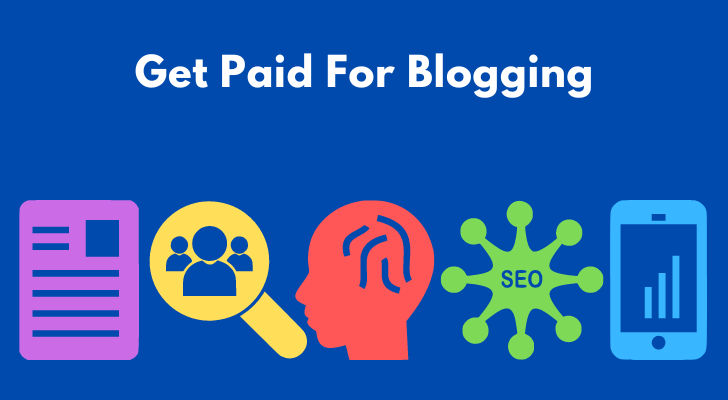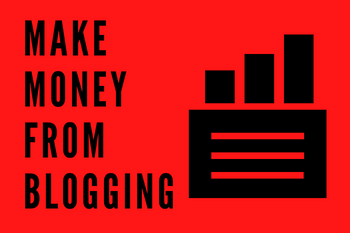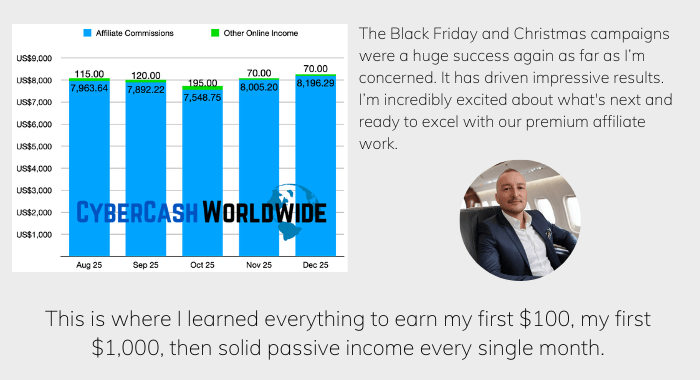Get paid to blog and turn your obsession into an income stream. I can tell you that the ways you can monetize your blog are terrific. Your blogging platform allows you to be as creative as you like, you own responsibility for what you say, and get paid for it. From affiliate marketing to sponsored posts, and everything in between - I’ll cover all the basics and provide some tips on how to get started. So if you’re looking for ways to make money from writing online, you’ve come to the right place!

Is Blogging Dead?
Asking if blogging is dead is like asking if social media is dead. There’s nothing special about it because there are millions of bloggers in the world. But it still gives you the freedom of sharing your thoughts and ideas with the world, so as long as you feel you can take advantage of it, blogging is not dead.
Surely Social Media Is Good Enough?
No. Social media is full of naysayers. If you want to only interact with positive people, you can do so by ignoring negative ones or blocking them. Whether you use Twitter or Instagram, you are just one of the billions of users who post their quick opinions and complaints day-in, day-out. And whatever you do, cyberbullies and trolls still exist.
What makes blogging different from social media is that it’s all yours. You are the owner of the blog. Of course, naysayers may leave negative comments, but you’ll also have the final say.
If anonymous social users want to say bad things about you across social media, let them. As long as you are proud of your content, you are in total control. That’s one of the best things about blogging.
Any Other Benefits of Blogging?
There’s no doubt blogging is a good way to supplement your income. If you can build up a large enough following, you may be able to eventually quit your day job and blog full-time - making significantly more money than you would at a traditional 9-5 job.
Of course, you wouldn’t just start blogging for the sole purpose of making money.
Blogging will help you build up your writing portfolio and skillset. This is important whether you’re looking to eventually transition into freelance writing or another creative field. A blog gives you a platform to practice your writing and hone your craft – something that will definitely come in handy down the line.
Blogging can also be therapeutic. If you enjoy writing and have something to say, it can be very cathartic to get your thoughts and feelings out there. It can also be helpful to connect with other like-minded people who might be going through similar experiences as you – something that can be difficult to do in real life.
You can start a blog for free, and there are many different platforms to choose from. You can create your blog site using WordPress pretty easily, and you can start writing posts right away while you tweak the layout, menu bar, etc. Each post should be about a specific topic, and you can include images and videos to make your posts more engaging.
How Can You Make Money from Blogging?

There are a few ways that bloggers can make money from their blog. Affiliate marketing to start with, you can sell your own products directly on your blog site such as ebooks, and you can start your own course if you are good at teaching. When you start to build a large enough audience, you can do anything to monetize your blog and make some extra money. So here are the options.
Advertisements
One way is through advertisements. Companies will pay bloggers to place ads on their blogs. The amount of money a blogger can make from advertisements depends on the traffic their blog receives. The more traffic, the more money they can make. Advertisements can be a great way to generate income from your blog, so long as you choose the right ad network and placement for your audience.
Advertising networks like Google AdSense, Media.net, or Mediavine (although your site will need 50,000 sessions in the past month to be approved) offer cost-per-click (CPC) or cost-per-thousand-impressions (CPM) advertising programs that can be placed on your blog. These programs allow you to set a budget for your ad campaign and choose keywords that will target your audience.
When choosing ad placements, it's important to consider where your audience is most likely to see them. For example, if you have a food blog, you might want to place ads on recipe pages or in the header or sidebar of your blog. Placing ads in locations where they are most likely to be seen by your target audience will help you generate more clicks and income.
Affiliate Marketing
Affiliate marketing is a type of online advertising in which a blogger promotes a product in exchange for a commission on sales. For example, if a blogger writes a review of a new book on their blog and includes an affiliate link to buy the book, they would receive a small commission if someone clicks on their link and buys the book.
Affiliate marketing is a “must” to make money from your blog, as you only need to promote products that you are already familiar with and that you believe in. Choose products carefully and disclose your affiliation clearly to avoid any potential conflict of interest.
If you're interested in affiliate marketing, there are many programs and resources available to help you get started.
How I "Finally" Make Over $7,000 Monthly Income
"The most valuable thing I've ever done!"
Sponsored Posts
If you're a blogger, you can get paid to write sponsored posts for brands. A sponsored post is a blog post that includes a product placement or mention of a brand. As a blogger, you can use your platform to promote products that you believe in and that are relevant to your readers.
Brands will pay you to write about their products in order to reach your audience. As a blogger, you can choose which brands you want to work with and which products you want to promote.
Strict guidelines are set by each brand, and you’ll be provided with the sponsored post guideline before you agree to write for them. The guidelines usually include;
- Your content and the product you mention must be relevant to your blog's niche.
- If you are promoting a particular product or brand, the post will be tagged as sponsored so that your readers are aware of the arrangement.
- You must be honest in your review of the product - don't just say something is amazing if it's not.
If you follow these guidelines, writing sponsored posts can be a great way to earn money from your blog while also providing valuable information to your readers.
Writing and Selling E-books

If you're a blogger, there's a good chance you've also thought about writing and selling an e-book. And why not? The fact that you have published a book will add credibility to your profile, and it’s certainly a great way to monetize your blog and reach a larger audience.
Writing an e-book is a time-consuming process, but when finished, it will be your asset for years to come. So here's a step-by-step guide to help you get started:
1. Choose a topic for your e-book
This should be something that you know a lot about and that your readers will find valuable. It could be a how-to guide, an inside look at your industry, or even just a collection of your best blog posts.
2. Write
You can hire a ghostwriter or write it yourself, but either way, make sure the writing style reflects your personality and is edited before moving on to the next step.
3. Create a sales page for your e-book.
This is where potential buyers will go to learn more about your e-book and decide whether or not to buy it. Your sales page should include things like an overview of the book, testimonials from early readers, and information on how to purchase the book.
Offering Consulting or Coaching Services
If you have expertise in a particular subject, such as law, or accountancy, you can offer consulting or coaching services to others through blog content. This is a great way to monetize your site and earn an income from your knowledge and experience.
- Choose a niche that you know inside out and that you can share your expertise with others.
- Share your knowledge through blog posts - each post should have a different topic with the right SEO keywords.
- If you can, offer a free consultation but indicate what you are willing to do for free and what you will charge.
- Create a pricing plan page and place it in the top navigation bar so visitors will know immediately what your paid service is.
- Set up a process for delivering your services so that both you and your client know what to expect. This could include sending over initial questions, scheduling regular check-ins, or providing feedback on progress.
- Promote your services on your blog and by creating a Facebook page. Make sure potential clients know that you're available for hire.
Creating a Membership Site
Adding a membership component is another way to monetize your blog site, and there are quite a few possibilities, such as;
- Offering a course/webinar.
- Selling “unlimited” access to a bundle of products.
- “Secret” content
The idea of creating a members-only area within your blog site is the SEO purpose. It’s the various keywords used in your blog content that draw visitors through search engines.
You could simply make the entire site members-only and promote it elsewhere to drive traffic such as;
- Though Facebook groups
- Use PPC ads (Google Ads, Facebook Ads)
- Use solo ad traffic services
Whereas if you add a members-only area to your blog site, you can expect organic traffic (people find your site on Google) so long as you keep posting blog entries.
You can keep publishing informational content as normal blog posts - something like an introductory guide to a hobby or skill, or a more in-depth look at a particular subject, but charge for further, more valuable content.
Course/Webinar
If you are good at speaking in front of a camera, then it's a whole different ballgame. By all means, you can publish your webinar - live or pre-recorded - in the members' area and charge the attendees.
The course you offer doesn’t necessarily have to be in a video format. You can create text-only course modules, though people generally prefer courses with video content (wholly or partly.)
Thrive Apprentice plugin allows you to create a members-only course program on your WordPress blog site.
Selling Unlimited Access
If you well multiple items through your blog site and charge a one-off price per item, you can also create a members-only area and give them full access. For example;
- You sell 10 books for $5 each. But you also offer an unlimited access area for $40. The members can get all 10 books plus bonus books and related discount vouchers for third-party products.
- You sell software for $50 with one-year support. But you also offer a yearly membership area for an extra $10 per year for extended support and unlimited updates.
“Secret” Content
You can create an area where you share the content only with paid members. For example conspiracy theories.
Create a Membership Area with Thrive Apprentice
Thrive Apprentice is a WordPress plugin that allows you to create, manage and deliver online courses. It includes everything you need to create an online course, including:
- A drag-and-drop course builder
- A membership area to protect your content
- A payment gateway to sell your courses
- A learning management system to track progress and completion
With this plugin, you can turn your WordPress site into a fully functional learning platform with all the bells and whistles.
But not restricted to courses because of its versatility, you can also use it to create a restricted area simply to share secret content with paid members.
How Does Thrive Apprentice Work?
With Thrive Apprentice, you can add videos, quizzes, assignments and other media to your blog site.
If you are creating a course, then this plugin makes it easy to track student progress and activity. You can see which lessons they have completed, how long they spent on each lesson, and their quiz scores.
Thrive Apprentice integrates with popular email marketing platforms like MailChimp and AWeber, so you can automatically send course updates and reminders to your students.
The Benefits of Using Thrive Apprentice

Thrive Apprentice Plugin
There are many benefits of using Thrive Apprentice for learning online courses.
- It’s a very affordable learning management system.
- It comes with a powerful editor that makes creating and managing your course content very easy.
- It provides you with a great way to track your student's progress.
- It offers a quiz feature to help assess your student's understanding of the material.
- Plus, with features like course completion certificates and progress tracking, you can get the students motivated and on track as they learn.
Who Should Use Thrive Apprentice?
Thrive Apprentice is an excellent tool for;
- Bloggers: Anyone who wants to share members-only content within the blog site.
- Product Sellers: You can sell pre-released items or a beta version of a product only to paid members.
- Instructors: If you're an instructor who wants to create an online course, there's no need to hire a separate development team or use a complicated learning management system (LMS).
- Employers: If you own a business, you can use Thrive Apprentice to train your employees. With the plugin's built-in reporting features, you can track employee progress and ensure they're mastering the material.
Thrive Apprentice is easy to set up, has great features, and provides a simple way for you to monetize your content. If you are looking for a reliable e-learning platform with plenty of options and features then Thrive Apprentice could be the perfect choice for you.
Accepting Donations from Readers
Alternatively, you can ask your readers to “buy you a cup of coffee.”
If you have something worthwhile to offer on your site and you feel truly proud of it, there’s no reason why you shouldn’t ask for a few dollars in return. The key is to make sure that you are actually providing something that could be potentially sellable.
For example, if you are a keen photographer, you can;
- Display one photo that you’ve taken on each blog post, and make the original (high-res) version of the photo downloadable. Tell visitors that the photo is your original, but they are free to use it for either personal or commercial purposes.
- Start your blog content underneath the photo - you can write a story behind the photo, some photography tips, or whatever you think is relatable.
Digital photos have very little value nowadays because there are many royalty-free image sites out there. But the fact that all the photos are your own may be appreciated by some.
If your blog is simply a collection of personal thoughts or ramblings, it's unlikely that people will be willing to donate money to it, unless the content is really outrageous or entertaining.
The other thing is that you’re not actually going to spend all the donations (if received) on coffee. Unlike charging a service fee, the donors have the right to know what their donation will be used for. So be transparent - tell them that their money will go towards maintaining your blog site or purchasing a new design tool for your site, for example. Be specific.
Get Paid For Blogging: Final Words
With the right dedication and strategy, it is possible to monetize your blog and start making an income from your writing. You could also use your blog as an avenue in which to share valuable information or showcase products that you have created.
Whatever route you decide to take, I hope this guide has inspired you and given you some ideas on how to get started!


hello sir I have years of experience as a blogger. I have over 2 years of experience on freelance writing including a lot of different niches. I am willing to work with your company. please tel me when i can start and if i can start what should i write about. Waiting for a positive reply.